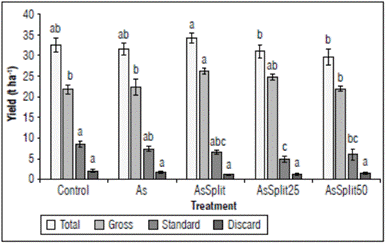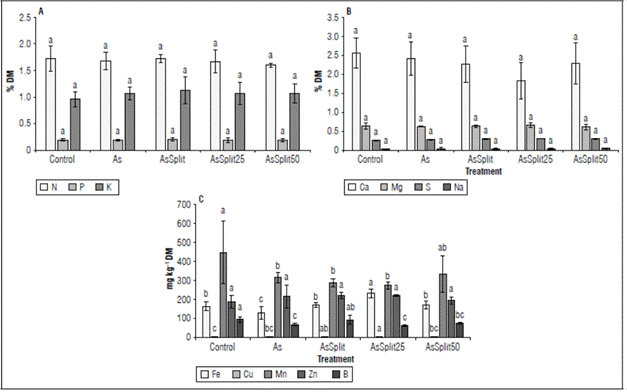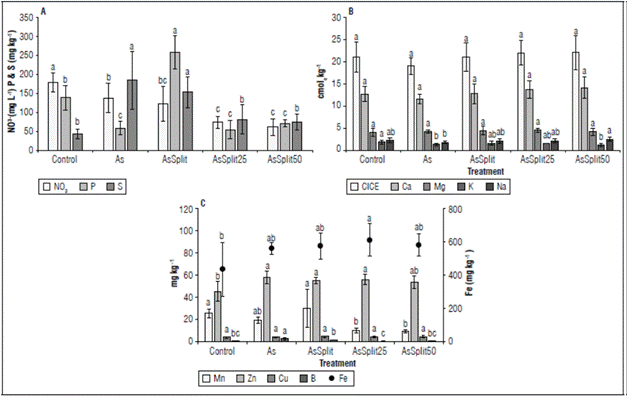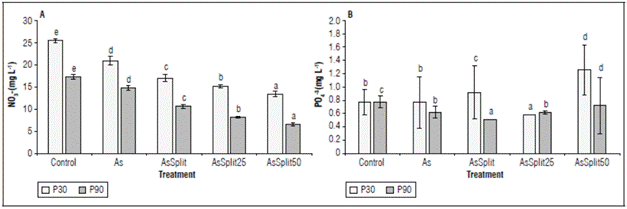INTRODUCTION
The most important item in terms of costs in potato crops in Colombia is fertilizers (mineral fertilizers, amendments, and correctives), with 21.16%, followed by wages (19.18%), pesticides (14.49%), and seeds (11.67%) (Fedepapa and Minambiente, 2004). Close to 2,000 kg of fertilizers per hectare are used during the whole cycle (Rios et al., 2010).
Traditionally, fertilization is done at two times in the crop cycle in potato crops in Colombia: pre-planting and hilling (or at weeding) (Pérez et al., 2008). A significant amount of fertilizers is lost through fixation (mainly phosphorus), immobilization or leaching (mainly nitrogen). The fixation of phosphorus in commercial potato cropping systems can reach 50% of the phosphorus applied (Ekelöf, 2007). Nitrate losses measured in commercial potato fields and experimental trials commonly exceed 10 mg N L-1 (Zebarth and Rosen, 2007).
Providing the necessary amount of nutrients at the right time trough fertigation or split fertilization is an option to increase yield and minimize the environmental and economic impacts of cropping systems. In that sense, Añez and Espinosa (2006) found that potato tuber yields were higher with treatments using N and K split applications. Similarly, Battilani et al. (2008) concluded that split fertilization of N with fertigation increases the efficiency of N in potato cultivation. Burton et al. (2008) found that split fertilization in potatoes substantially reduced N2O emissions to the environment, especially in times of high rainfall. However, Pérez et al. (2008) found a lower yield and quality in Criolla potato tubers with split fertilization using NPK-Mg at two times (as is traditionally done in Colombia), as compared to the total required fertilization applied in pre-planting. Likewise, Kuisma (2002) found that there was higher yield when 100% of the N was applied at the time of planting, as compared with split fertilization.
Experiments on fertilization in potatoes generally evaluate the effect of nitrogen, phosphorus, or potassium, individually or combined at different levels to find the element and doses that determine the best plant response. Plants need 17 essential elements, eleven of which can be applied through fertilization (Marschner, 2012). Assessing combined doses of these eleven elements in factorial experiments is very complicated and requires a lot of resources. However, if complete fertilization formulas are evaluated and enough variables of plant and soil are measured and correlated, it may be possible to find which elements and which interactions define potato plant behavior in terms of yield.
The objective of this study was to evaluate the effect of split fertilization on potato soil and plants.
MATERIALS AND METHODS
This experiment was carried out during the first half of 2016 in Plot 49, located in the Tibaitata Research Center of Agrosavia, in Mosquera, Cundinamarca, Colombia (4°41'18.84'' N - 74°12'22.67'' W), with an altitude of 2,560 m a.s.l., average humidity 80% and average temperature of 13.5°C. Potato seeds (Solanum tuberosum) from the ‘Diacol Capiro’ variety were used. Table 1 shows the chemical properties of the experiment soil in this study.
Table 1 Chemical properties of the soil where the study was carried out. Sampling before planting.
| Property | Unit | Value |
|---|---|---|
| pH | 5.66 | |
| Electric conductivity (EC) | dS m-1 | 2.16 |
| Effective cationic Exchange capacity (CEC) | cmolc kg-1 | 19.46 |
| Organic matter (MO) | % | 10.58 |
| Nitrate (N-NO3 -) | mg L-1 | 13.15 |
| Available phosphorous (P) - Bray II | mg kg-1 | 24.82 |
| Exchangeable potassium (K) | cmolc kg-1 | 0.65 |
| Exchangeable calcium (Ca) | cmolc kg-1 | 13.21 |
| Exchangeable magnesium (Mg) | cmolc kg-1 | 3.91 |
| Exchangeable sodium (Na) | cmolc kg-1 | 1.69 |
| Available sulfur (S) | mg kg-1 | 108.78 |
| Available iron (Fe) | mg kg-1 | 718.3 |
| Available manganese (Mn) | mg kg-1 | 7.12 |
| Available zinc (Zn) | mg kg-1 | 42.9 |
| Available copper (Cu) | mg kg-1 | 6.44 |
| Available boron (B) | mg kg-1 | 0.41 |
A complete randomized design with five treatments and four reps was established, for a total of 20 experiment units. Each one had 16 m2, totalizing 320 m2 for the experiment area. The crop was planted at 0.35 m between plants and 0.9 m between rows. Each experiment unit had four rows, and each row had 11 plants, for a total of 44 plants per experiment unit (plant density: 2.8 plants/m). The treatments are listed below and are detailed in table 2:
Table 2 Amount of nutrients applied for each treatment.
| Treatment | N | P | K | Ca | Mg | S | Fe | Mn | Cu | Zn | B |
|---|---|---|---|---|---|---|---|---|---|---|---|
| kg ha-1 | |||||||||||
| Control | 292 | 297 | 354 | 321 | 458 | 109 | 130 | 4 | 2 | 6 | 5 |
| As | 150 | 90 | 271 | 90 | 183 | 109 | 150 | 3 | 4 | 5 | 4 |
| AsSplit | 150 | 90 | 271 | 90 | 183 | 109 | 150 | 3 | 4 | 5 | 4 |
| AsSplit25 | 112 | 67 | 203 | 68 | 137 | 81 | 112 | 2 | 3 | 4 | 3 |
| AsSplit50 | 75 | 45 | 136 | 45 | 92 | 54 | 75 | 1 | 2 | 2 | 2 |
Control - fertilization commonly used by farmers (type of fertilizers, amount, and timing).
As - fertilization recommended by the Agrosavia soil laboratory (type of fertilizers, amount, and timing, according to plant requirements and soil characteristics [Tab. 1]).
Assplit - monthly split fertilization recommended by the Agrosavia Soil Laboratory. Designed based on the treatment characteristics, phenology stage of the plant, nutrient absorption curve and soil characteristics (Tab. 1)
AsSplit25 - monthly split fertilization recommended by the Agrosavia Soil Laboratory, reducing the amount of fertilizer by 25%.
AsSplit50 - monthly split fertilization recommended by the Agrosavia Soil Laboratory, reducing the amount of fertilizer by 50%.
Tubers of all 10 plants, from the central area of each experiment unit, were weighed and classified. The tubers were classified based on traditional standards used in Colombia, according to sizes in gross (7-14 cm), standard (3-7 cm), discard (< 3 cm), and total (sum of all categories).
At the end of tuber filling (20-24 weeks after planting), the total N content was determined in leaf tissue using the micro-Kjeldahl method and volumetric titration. The total P was determined with calcination at 475°C and colorimetric titration with molybdate and ammonium vanadate (Fernández et al., 2017). The total K, Ca, Mg, Na, Fe, Mn, Cu, and Zn were calculated with calcination at 475°C and titration with atomic absorption spectrophotometry. The total S used incineration with magnesium nitrate and turbidimetry, and the total B was determined with calcination at 475°C and colorimetric titration with azometin-Ha.
Losses of NO3 - and PO4 3- through leaching were measured. In each experiment unit, two suction lysimeters were installed, one at 30 cm and another at 90 cm deep. The concentration of NO3 -, and PO4 3- were measured according to NTC 5167. Under natural conditions (fallow, no fertilization) measurements were taken.
The pH was measured at the end of the crop cycle with the potentiometric method; the organic matter (OM) was calculated with the Walkley-Black method; exchangeable bases (K+, Ca2+, Mg2+, and Na+) used the 1M NH4 Acetate pH 7 method through atomic absorption spectrophotometry; the Effective Cation Exchange Capacity (ECEC) was determined as the sum of the exchangeable bases; P used the Bray II method; S and B were determined with extraction with monobasic calcium phosphate, and Fe, Mn, Cu, and Zn used the modified Olsen method.
A correlation matrix determined whether there was a relationship between the variables. For differences between treatments, an univariate analysis of variance (ANOVA) and a multiple comparison test of Tukey were performed. All variables, before the ANOVA, were tested for normality (Shapiro test) and homogeneity of variances (Bartlett test). The data process was carried out with R-Project x 64 3.6.3 (R Core Team, 2017), mvoutlier packages (Filzmoser and Gschwandtner, 2015), agricolae (Mendiburu, 2015), nlme (Pinheiro et al., 2016) and ggplot (Wickham, 2016).
RESULTS
The correlation analysis showed that the P and N concentration in the leaf tissue correlated significantly with the total yield, with a correlation of 64 and 63%, respectively (data not shown).The NO3 - concentrations, in solution and leachates at 30 and 90 cm, had a significant correlation with each other (80 and 81%, respectively, data not shown) and with the standard potato category. The correlation analysis showed significant correlations between the pH, ECEC, Ca2+ Na+, and Mg2+ (data not shown). Table 1 shows that, for the exchangeable bases, Ca2+ had the highest concentration, followed by Mg2+, Na+, and K+, which is consistent with that reported in the correlation analysis.
The monthly split fertilization recommended by the laboratory (AsSplit, Tab. 2) generated the highest crop yield, with 34.13 t ha-1, followed by the treatments Control and As, with 32.47 and 31.53 t ha-1, respectively (Fig. 1), while the treatments with reduced amounts of fertilizers (AsSplit25 and AsSplit50) obtained lower yields, 30.94 and 29.57 t ha-1, respectively.
For tuber quality, differences for the gross category were found, where AsSplit obtained the highest yield (26.3 t ha-1), followed by AsSplit25 (24.7 t ha-1). For the standard category, the Control treatment obtained the highest yield (8.5 t ha-1) (Fig. 1). For the discard category, significant differences between treatments were not found (Fig. 1).

Figure 1 Total yield and discrimination by selection category. Treatments with the same letter do not have significant differences (P>0.05). Data are the mean of four observations (n = 4). The error bars indicate standard error.
The differences in yield between the treatments were not explained by leaf tissue nutrient concentrations. As shown in figure 2, major (N, P, and K), secondary (Ca and Mg) nutrients and Na were found at similar concentrations in the leaf tissue independent of the fertilizer plan. Only S had a lower concentration in the leaf tissue of those plants fertilized with the Control and As (Fig. 2).

Figure 2 N, P, K, Ca, Mg, S, Na, Fe, Cu, Mn, Zn, and B concentration in potato leaf tissue, in terms of dry matter (DM) percentage. Treatments with the same letter do not have significant differences (P>0.05). Data are the main value of four observations (n = 4). The error bars indicate standard error.
There were highly significant differences in the micronutrient concentrations in the plant tissue, Zn and Mn; the main microelements absorbed by the plants in all treatments. The potato plants treated with AsSplit25 cumulated the highest amount of Fe and Cu, which indicated that fertilization with these micronutrients could be reduced up to 25%. At the same time, Mn and B were concentrated mostly in the Control plants (Fig. 2). There were no differences in the concentration of B between the plants fertilized by the producer and those that received the split fertilization recommended by the laboratory (AsSplit). Also, the Mn concentration in leaf tissue did not show differences between the farmer fertilization and 50% of the applied dose of the recommended fertilization.
The pH of the soil in this study was acid (Tab. 1). The soil that received AsSplit25 and AsSplit50 had a higher pH, 5.44 and 5.45, respectively, whereas the soil with AsSplit had the lowest pH, 4.99 (data not shown) and generated the highest yield (Fig. 1).
The soil in the Control had the highest NO3 - concentration, with 178 mg L-1, followed by As and AsSplit, with 138 and 123 mg L-1. This is consistent with the amount of N applied to the soil (Control 292, As, and AsSplit 150 kg ha-1) (Tab. 2) and with the yield, where AsSplit, Control, and As were the treatments with the highest yield. AsSplit showed the highest concentration of available P in the soil. For sulfur, the highest concentration was in the soils that received the plan recommended by the laboratory, and this concentration did not change with or without the fertilizer split (Fig. 3).

Figure 3 NO3 -, P, S, Ca, Mg, K, Na, Mn, Zn, Cu, B and Fe concentration and CICE of the soil, measured at 24 weeks after planting. Treatments with the same letter did not show significant differences (P>0.05). Data are the mean of four observations (n = 4). The error bars indicate standard error.
Significant differences were not seen for the exchangeable bases in the soil as a result of the effect of fertilization treatments, as seen for K+ in the soil since the Control had the highest concentration (Fig. 2), with the highest amount of applied potassium (Tab. 2). This result was not consistent with the leaf tissue potassium content (Fig. 2) or the yield (Fig. 1).
The soil in the AsSplit treatment had a high concentration of Mn2+ and Zn2+ , while Fe2+ accumulated mostly in the soil of the AsSplit25 treatment, and B accumulated in those that received As (Fig. 3). For Cu2+, there were no significant differences (Fig. 3).
The Control, which is the treatment that most N applied through fertilization, accumulated the highest amount of NO3 - in the leachate, while AsSplit50, which applied the least amount of N, accumulated the lowest concentration of NO3 -, both at 30 and 90 cm (Fig. 4). For PO4 -3, the leachates were significantly lower than NO3 -, and the differences between the depths 30 and 90 cm had significantly fewer differences than NO3 - (Fig. 4).
DISCUSSION
Splitting generates a higher yield but does not promote a reduction in the amount of fertilizer applied. The treatments where the fertilization reduction was tested, had the lowest yield with this trend: AsSplit > Control = As > AsSplit25 > AsSplit50. Despite these results, no statistically significant differences in nutrient leaf tissue concentrations were found. This could happen because this parameter is expressed in terms of dry matter of just one plant. Yield is expressed in terms of the production of all plants in 1 ha. Regardless of the statistical results, the nitrogen and phosphorus leaf tissue concentration trends were consistent with those of yield: AsSplit > or = Control > As > AsSplit25 > AsSplit50 and with the PCA analysis (mainly for nitrogen) (Fig. 1).
Even though the Control had the highest concentration of nitrate in the soil solution, AsSplit obtained the highest yield, applying almost half of the doses applied in the Control. Splitting this nutrient, according to the plant phenology, promotes higher absorption, which explains why AsSplit had the highest leaf tissue nitrogen accumulation and the highest yield. Li et al. (2008); Sahahnazari et al. (2008) and Singh and Singh (2020) stated that N is the element that most frequently limits potato yield, thus, as the concentration of N in the soil increases, an increase in tuber mass, dry mass, and yield is generated. Nitrogen influences the amino acid composition of proteins and, in turn, their nutritional quality (Setu and Mitiku, 2020).
The fertilization applied in the Control and As generated the highest NO3 - concentration, both in the soil solution and at 30 and 90 cm. The application of fertilizer in these treatments was not split, which led to the highest loss of NO3 - in leachates. The NO3 - concentration, both in solution and leachates at 30 and 90 cm, had a significant correlation with each other and with the standard potato category because NO3 - is a highly mobile anion in the soil (Scheffer and Schachtschabel, 2016), which implies that, by increasing its concentration in the soil solution, an increase in its concentration in leachates is also expected. In general, at 30 cm, there was a higher NO3 - concentration than at 90 cm. This difference in the NO3 - concentration was reduced with splitting, and the amount of fertilizer applied was reduced with the following sequence: Control > As > AsSplit > AsSplit25 > AsSplit50. These results suggested that splitting and decreasing the amount of fertilizer resulted in a lower loss of N on the surface and at depth. However, the leaching of N was significantly higher than in in natural conditions (no fertilization, fallow), with 0.5 mg L-1 at 90 cm depth (data not shown), as compared with 17.3, 14.8, 10.6, 8.1, and 6.5 mg L-1 at the same depth for the Control, As, AsSplit, AsSplit25, and AsSplit50, respectively.
For MDA (2018), 10 mg L-1 of N is the health risk limit in groundwater, just treatments with splitting (AsSplit25 and AsSplit50) are at the optimum threshold. The AsSplit and Control treatments exceeded that limit by 47 and 73%, respectively. Groundwater is one of the most important sources of drinking water in the world. Concerns about increasing groundwater concentrations of NO3 - from agricultural sources are for both human-health and the environment (Shrestha et al., 2010). Bohman et al. (2020), Alva (2010), and Quemada et al. (2013) stated that, although the existing nitrogen best management practice is effective at controlling N losses, the development of alternative practices is needed to reduce the risk of groundwater contamination. Bohman et al. (2020) found that percolation, driven by precipitation and irrigation, is a more critical leachate-generator factor than fertilization split. In our study, there were no water excesses because it was carried out in a dry season, using drip irrigation.
Although the Control treatment applied the highest amount of P through the fertilization, AsSplit showed the highest concentration of available P in the soil. The P split effect was seen because, although AsSplit applied 30% phosphorus as compared to the Control, the concentration in the soil was two-fold higher than the Control, and this fact resulted in a higher yield. This may have happened because the high concentration of calcium in the soil meant the phosphorus could be fixed in the form of calcium phosphate (Ca3(PO4)2), which is unavailable for plants. By splitting the P, the plants treated with AsSplit can absorb a higher amount of P before it is fixed. Commonly, no differences in yield were found for the variable rates of phosphorus applied to the soil (e.g., Setu and Mitiky, 2020; Nyiraneza et al., 2017), but the causes were not clear. Rosen and Birman (2008) stated that the application of phosphorus increased crop yield and reduced the number of discarded tubers. For PO4 -3, despite the application of phosphate fertilizers [DAP - (NH4)2HPO4], the PO4 -3 anion precipitated in the soil because of the high Ca2+ concentration (Tab. 1), probably because of calcium phosphate, which prevents PO4 -3 from being leached. As compared with the amount of phosphate leachate from natural conditions (0.6, and 0.4 mg L-1 at 30 and 90 cm depths, respectively), there were no significant differences with the fertilization treatments, where the Control released the highest amount of phosphate through the leachates (0.77 mg L-1 both at 30, and 90 cm depths). Traditionally, farmers apply high amounts of P. The soil in the Control had the highest PO4 3- leaching at 30 and 90 cm.
According to the leaf tissue concentration, K, Ca, and Mg had not influence the yield. Probably, no differences could be seen because of the amount of K, Ca, and Mg fertilizer even though, at lower concentrations (AsSplit50; K 136, Ca 45, Mg 92 kg ha-1), there was optimal plant development. Helal and Abd-Elhady (2015) found that 130 and 44 kg ha-1 of K and Ca, respectively, were enough for vegetative growth and yield in potato plants.
Despite the differences in the concentration of minor elements in the soil in the treatments, differences in leaf tissue concentrations were not seen, which could be due to the content of these nutrients in the soil of all treatments, which met the plants’ needs. The most important result in this regard is that, independent of the treatment, the potato plants had high amounts of Zn and Mn in the leaf tissue. Mousavi et al. (2007) demonstrated the positive effect that Zn has on potato tubers because of the metabolic role of this micronutrient in protein synthesis, enzymes activation, and carbohydrate metabolism.
CONCLUSION
When a fertilization formula is designed according to the requirements of potato plants and soil fertility and this is applied according to the plant phenology, a higher total production of tubers is generated, i.e., a higher yield. At the same time, splitting and fertilizer reductions generate a positive environmental effect since the concentration of NO3 - in the leachates decreases as the fertilizer dose is split, and its amount is reduced. However, despite the fact that splitting the total dose of fertilizers leads to a higher yield, there is no correlation with a reduction in the amount of fertilizer applied. The treatments where the split was accompanied by a reduction, 25 and 50%, had a lower crop yield.
















